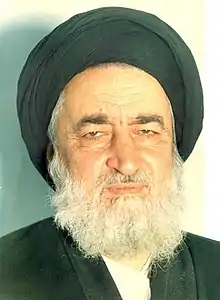Mir Asadollah Madani
Mir Asadollah Madani Dehkharghani (Persian: میر اسدالله مدنی دهخوارقانی; born 1914 in Azarshahr, East Azerbaijan – died September 11, 1981 in Tabriz, East Azerbaijan) was an Iranian politician and Shia cleric. He was the second Imam Jumu'ah of Tabriz, the Imam Jumu'ah of Hamadan, the representative of the Supreme Leader in East Azerbaijan[1] for less than a year, and a member of the Muslim People's Republic Party. Madani was also Hamadan Province's representative in the first term of the Assembly of Experts.[2]
Mir Asadollah Madani | |
|---|---|
میر اسدالله مدنی | |
 | |
| Imam Jumu'ah of Tabriz | |
| In office 1981–1981 | |
| Appointed by | Ruhollah Khomeini |
| Preceded by | Mohammad-Ali Ghazi-Tabatabaei |
| Succeeded by | Moslem Malakouti |
| Imam Jumu'ah of Hamadan | |
| In office 1979–1981 | |
| Member of the Assembly of Experts | |
| Constituency | Hamadan Province |
| Personal details | |
| Born | 1914 Azarshahr, Iran |
| Died | September 11, 1981 Tabriz, Iran |
| Cause of death | Assassination (detonation of hand grenade) |
| Alma mater | Qom Hawza & the Hawza of Najaf |
He was assassinated[2] on September 11, 1981 by a member of the People's Mujahedin of Iran while praying in Tabriz after Mohammad-Ali Ghazi-Tabatabaei. Because of his assassination, he is sometimes referred to as "the second martyr of Mihrab."[3]
Political activity
In 1970, Mir Asadollah Madani returned to Iran in opposition to the rule of Mohammad Reza Pahlavi. However, his actions resulted in him being exiled to Bandar Kangan. He was later arrested by SAVAK and was deported several times in the 1960s. During that time, he was diagnosed with pulmonary tuberculosis. Based on his medical records and death, there is a strong belief that he died of that disease. He used SAVAK to escape the pressures of the religious spectrum in 1972, banishing him to the Valley Moradbeik around Hamedan. [4] After the 1979 Iranian Revolution, he was appointed as the Imam of Tabriz.[4]
Assassination
On September 11, 1981, at the end of the Friday prayer, Madani was approached by an unknown man. The man then detonated a grenade that was hidden under his clothes, which led to the death of Mir Asadollah Madani and three others, as well as leaving 50 people injured. Madani was killed in a mihrab[5] and hence acquired the title "the second martyr of Mihrab," the first one being Ali ibn Abi Talib who was also assassinated while praying.[6] MEK claimed responsibility for the assassination.[5][7]
Commemorations
- Azarbaijan Shahid Madani University, a public university in his hometown
- Shahid Madani Metro Station, a station on the Tehran Metro Line 2
- Shahid Madani of Tabriz International Airport
- Operation Shahid Madani, an operation launched by the Islamic Republic of Iran Army in the Iran–Iraq War (1982)[8]
- Shahid Madani Dam in Tabriz[9]
- Shahid Madani Heart Hospital in Tabriz[10]
- Shahid Madani Hospital in Khorramabad[11]
References
- Montazam, Mir Ali Asghar (1994). The Life and Times of Ayatollah Khomeini. London: Anglo-European Publishing. ISBN 978-1-898677-00-0.
- Behdad, Sohrab (1997). "Islamic Utopia in Pre-Revolutionary Iran: Navvab Safavi and the Fada'ian-e Islam". Middle Eastern Studies. 33 (1): 40–65. ISSN 0026-3206.
- "آیت اللهی که توسط منافقین به شهادت رسید+تصاویر". Mashregh. August 2014. Retrieved 26 August 2015.
- Mousavi, Rouhollah. "Mir Asadollah Madani". pajoohe.
- "A review on the scientific and fighting life of Martyr Madani". Political Studies and Research Institute (in Persian). Retrieved 16 September 2018.
- "How many are martyrs of Mihrab and what are their names?". Fars News Agency. Retrieved 16 September 2018.
- altar Martyr. tebyan.
- "عمليات شهيد مدني". Fatehan. Retrieved 26 August 2015.
- "سد مدنی تبریز با مشکل تملک مخزن مواجه است". Fars News Agency. Retrieved 26 August 2015.
- "انجام یک عمل جراحی نادر در تبریز". fardanews. Retrieved 26 August 2015.
- "درباره بيمارستان شهيد مدني". madani.lums. Retrieved 26 August 2015.
| Wikimedia Commons has media related to Mir Asadollah Madani. |
| Political offices | ||
|---|---|---|
| Preceded by |
Imam Jumu'ah of Tabriz 1981- 1981 |
Succeeded by |